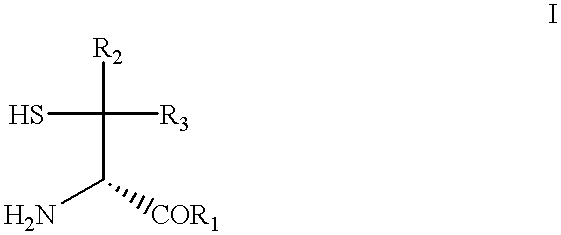N-terminal D(-)-penicillamine peptides as aldehyde sequestration agents
a technology of n-terminal d (-)-penicillamine and peptides, which is applied in the direction of peptides, peptide/protein ingredients, immunoglobulins, etc., can solve the problems of limiting the usefulness of aldehyde as a sequestration agent for ach, affecting the synthesis of aldehyde, and being more susceptible to its toxic effects
- Summary
- Abstract
- Description
- Claims
- Application Information
AI Technical Summary
Problems solved by technology
Method used
Image
Examples
example 1
D-Penicillamyl-.beta.-alanine Hydrochloride (6d).
[0087] A stirred solution of N-(3-Formyl-2,2,5,5-tetramethylthiazolidine-4-S-carbonyl)-.beta.alanine ethyl ester (1.00 g, 3.16 mmol) in 40 ml dioxane: 2 N HCl (1:1) was heated under N.sub.2 in a water bath at 85-90.degree. C. An aliquot sampled after 1.75 hours for NMR analysis indicated about 8% starting material remaining. After 3.75 hours, the reaction mixture was evaporated to dryness in vacuo, water was added, and the mixture evaporated to dryness again. NMR analysis indicated about 3% of the formyl group was still uncleaved, although the ester moiety was hydrolyzed. The product was reheated in 15 ml 1 N HCl for an additional 3.25 hours under N.sub.2 when NMR analysis indicated the reaction was complete. The solution was lyophilized to give 687 mg (79% yield) of 6d as a hygroscopic solid, mp 71-75 .degree. C. .sup.1H NMR (D.sub.2O): .delta. 1.32 (s, 3H, CH.sub.3), 1.38 (s, 3H, CH.sub.3), 2.52 (t, J=6.4 Hz, 2H, CH.sub.2CO.sub.2H),...
example 2
D-Penicillamylglycine Hydrochloride (6a)
[0091] N-(3-Formyl-2,2,5,5-tetramethylthiazolidine-4S-carbonyl)-glycine t-butyl ester (5a) (931 mg, 2.82 mmol) was hydrolyzed over 10 hours using the same procedure for 6d to give 587 mg of 6a (77% yield) as a hygroscopic solid, mp 67-71.degree. C. .sup.1H NMR (D.sub.2O): d 1.36 (s, 3H, CH.sub.3), 1.44 (s, 3H, CH.sub.3), 3.92 (s, 1H, CHCS) 3.92, (d, J=17.8 Hz, 1H, CHNCO), 3.97 (d, J=17.8 Hz, 1H, CHNCO); mass spectrum (FAB), m / z 207 (MH.sup.+).
[0092] N-(3-Formyl-2,2,5,5-tetramethylthiazolidine-4S-carbonyl)-glycine t-butyl ester was prepared as follows.
a. N-(3-Formyl-2,2,5,5-tetramethylthiazolidine-4S-carbonyl)-glycine t-butyl ester (5a)
[0093] To an ice-cooled solution of 3 (5.75 g, 26.5 mmol) and Et.sub.3N (7.50 ml, 5.45 g, 53.8 mmol) in CH.sub.2Cl.sub.2 (80 ml) was added isobutyl chloroformate (3.43 ml, 3.61 g, 26.5 mmol). The milky suspension was stirred for 1 hour and glycine t-butyl ester hydrochloride (4a, 4.44 g, 26.5 mmol) was added. The...
example 3
D-Penicillamyl-L-valine hydrochloride (6b)
[0094] N-(3-Formyl-2,2,5,5-tetramethylthiazolidine-4S-carbonyl)-valine t-butyl ester (5b) (1.07 g, 2.87 mmol) was hydrolyzed for 6 hours using the same procedure for 6d to give, after lyophilization, 780 mg of 6b (96% yield) as a fluffy solid, mp 263-265.5 .degree. C. (dec.) .sup.1H NMR (D.sub.2O): .delta. 0.84, 0.86 d, 1:1, J=6.8 Hz, 6.8 Hz, 6H, CH.sub.3CH), 1.36 (s, 3H, CH.sub.3CS), 1.43 (s, 3H, CH.sub.3 CS), 2.10, (m, 1H, CHCH.sub.3), 3.95, (s, 1H, CHCON), 4.15, 4.16 (d, 1:1, J=5.7 Hz, 5.7 Hz, 1H, CHCO.sub.2); mass spectrum (FAB), ml / z 249 (MH.sup.+).
[0095] N-(3-Formyl-2,2,5,5-tetramethylthiazolidine-4S-carbonyl)-valine t-butyl ester was prepared as follows.
a. N-(3-Formyl-2,2,5,5-tetramethylthiazolidine-4S-carbonyl)-valine t-butyl ester (5b)
[0096] 5b was prepared as for 5a using 2.17 g (10.0 mmol) of 3 in 30 ml CH.sub.2Cl.sub.2, Et.sub.3N (3.0 ml, 2.78 g, 22.0 mmol), isobutyl chloroformate (1.30 ml, 1.37 g, 10.0 mmol), and 4b (2.10 g, 10....
PUM
| Property | Measurement | Unit |
|---|---|---|
| Volume | aaaaa | aaaaa |
| Density | aaaaa | aaaaa |
| Density | aaaaa | aaaaa |
Abstract
Description
Claims
Application Information
 Login to View More
Login to View More - R&D
- Intellectual Property
- Life Sciences
- Materials
- Tech Scout
- Unparalleled Data Quality
- Higher Quality Content
- 60% Fewer Hallucinations
Browse by: Latest US Patents, China's latest patents, Technical Efficacy Thesaurus, Application Domain, Technology Topic, Popular Technical Reports.
© 2025 PatSnap. All rights reserved.Legal|Privacy policy|Modern Slavery Act Transparency Statement|Sitemap|About US| Contact US: help@patsnap.com



